| Columns Retired Columns & Blogs |
Great book!
Even if you don't give a fig about audio amplifiers, the sections in both this edition and the earlier one having to do with SPICE simulation - focused mostly on the use of the free (!) LTspice software application - make the book worth reading. If you do that sort of thing, of course. By that I mean, read and/or simulate circuits.
It's not just me saying that, either. Part of my day job responsibility is mentoring some new guys we have. I give them "homework assignments" centered around the use of LTspice. They all find this book very helpful; more helpful than I am, in fact.
For audio enthusiasts, the really funny thing is that by using LTspice you can learn a lot about why circuits behave the way they do. Often there are performance aspects that seem to track with listening observations. I am NOT saying that there's definite causality between some particular signal parameter and the sound, but it does make you wonder.
Plus, with simulation, it's often easy to examine some circuit details that can be hard to measure. Like power supply noise rejection over frequency. I wonder how often that is even measured. Some basic real world conditions, like the change of frequency response or even the stability of a circuit by varying the volume control are easy to look at in simulation.
The results are not perfect, because of the limitations of the models and the variation between the nominal device model and actual parts which vary in one parameter or another. (Tolerances and all that.) But, you do get a pretty decent idea of the overall trends.
Enough proselytizing by me. Educating yourself on these subjects is a lot like applying acoustic treatments to your listening room. Not many people want to be bothered, but both can give great results, especially for the price.








































